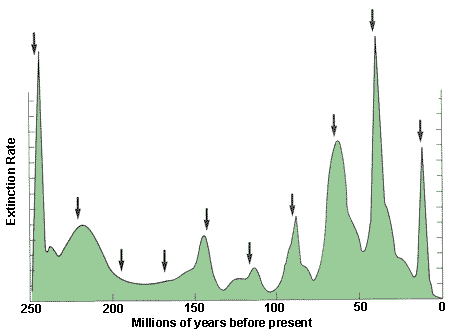The Consequences of Global Warming
What can we expect to happen in the next fifty years or so? We can draw some insight into this from what happened at the Paleocene/Eocene boundary, called the PETM, because something happened then that is very similar to what is happening now. And what happened then is that the planet warmed up to the point where it was 75 degrees Fahrenheit at the North Pole in the summer, and the oceans acidified causing the largest extinction of sea life in the history of our planet. Animal life adapted by moving towards the poles. What likely caused the global warming then was volcanic activity that released carbon dioxide into the atmosphere warming it which then caused methane hydrates to be released from under the oceans.
We are, however, pouring carbon dioxide into the atmosphere far more rapidly

We can't know exactly what is happening now, but from that graph we are forced to conclude that it is very likely to be far worse than what happened then.
It is going to be hot, and the oceans are going to acidify as they did then, but animal life will survive as it did then, even under a greater amount of heat. Life will go on, but maybe with humans or maybe without. Eventually the planet will equilibrate, absorbing the greenhouse gases in various ways. But until then, perhaps thousands of years, it'll be pretty hot.
Despite how it looks, the PETM was not one of the really serious extinction events:
It is proposed that these extinctions are caused by a very large object, a planetoid, they called Nemesis, in orbit around the sun that draws near Earth at 30 million year intervals, pulling asteroids out of orbit and plunging them into our planet and causing buckling in our planet's crust producing major volcanic activity and thus the extinctions, including the one that wiped out the dinosaurs.
Fortunately, though, we are halfway, about 15 million years from Nemesis returning, so we aren't going to have to worry about that kind of catastrophe for awhile.
We are, however, pouring carbon dioxide into the atmosphere far more rapidly
We can't know exactly what is happening now, but from that graph we are forced to conclude that it is very likely to be far worse than what happened then.
It is going to be hot, and the oceans are going to acidify as they did then, but animal life will survive as it did then, even under a greater amount of heat. Life will go on, but maybe with humans or maybe without. Eventually the planet will equilibrate, absorbing the greenhouse gases in various ways. But until then, perhaps thousands of years, it'll be pretty hot.
Despite how it looks, the PETM was not one of the really serious extinction events:
- The fossil record of the end Permian mass extinction reveals a staggering loss of life: perhaps 80–95% of all marine species went extinct. Reefs didn't reappear for about 10 million years, the greatest hiatus in reef building in all of Earth history.
What will probably happen if we do nothing about our pouring CO2 into the atmosphere will be nothing like that. There is some research that the major extinction events have occurred at roughly 26 to 30 million years apart.
 |
A PLOT OF DATA ON LIFE EXTINCTIONS, COLLECTED BY DAVID RAUP AND JOHN SEPKOSKI AT THE UNIVERSITY OF CHICAGO, SHOWS PEAKS IN THE EXTINCTION RATE OCCURRING AT 26- TO 30-MILLION-YEAR INTERVALS, AS INDICATED BY ARROWS |
Fortunately, though, we are halfway, about 15 million years from Nemesis returning, so we aren't going to have to worry about that kind of catastrophe for awhile.


Comments
Post a Comment